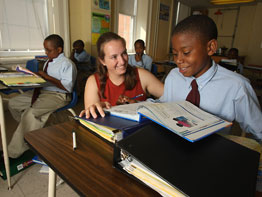There was a time when nearly every student’s eyes drifted to the classroom clock as they began to count the seconds to the final school bell of the day.
What was once a signal of freedom has become something far different. Books may shut, but schools continue to cultivate their students, hours beyond the official end of the day.
Students, it turns out, seem to like it.
“When the bell rings, it’s almost not enough,” said Christine Kaiser, dean of students at the all-girls Notre Dame Preparatory School in Towson.
Both urban and suburban Catholic schools address varying needs with the same approach. While suburban students often stay until 6 p.m., participating in clubs and sports, many urban schools have lengthened the school day with required activities in order to keep their students from the potential pitfalls of city life.
Whatever the ends, schools see the longer day as a means to nurture interests.
Baltimore’s St. Ignatius Loyola Academy, which serves boys in the sixth through eighth grades, is one of three schools in the archdiocese – the others being Sisters Academy of Baltimore and Mother Seton Academy – to follow the Nativity Miguel model, which provides opportunity “in underserved communities.”
“We try to provide an atmosphere for safety and growth,” said Christopher Wilson, St. Ignatius principal. “We aim to care for the whole child in providing a much wider program.”
Hopefully, students emerge from a cycle of poverty that has ensnared many in city life.
More than 90 percent of Nativity Miguel students across the country graduate from high school, compared to only 34 percent in Baltimore City public schools.
St. Ignatius has an 11-month program, with the main part of the year requiring students to stay until 5 p.m. Each day’s final hour is filled with required activities or sports.
“They don’t see the temptations that might strike them if they’re free all summer,” Mr. Wilson said. “In terms of their academic performance, we find that there’s more continuity to their learning.”
Cristo Rey Jesuit High School, which opened as a co-educational institution a year ago, implements a work-study program that immerses students in the Baltimore business community.
Students attend Cristo Rey until 6 p.m. at a heavily defrayed cost, with local businesses channeling money earned by the students in the work-study program back into the school.
“It’s a great program to help our students catch up in terms of basic fields of content,” said Father John Swope, S.J., Cristo Rey president. “It also closely mirrors the work day, eight or nine hours a day.”
Administrators say students like the school so much they have to be told to go home in the evening, a common theme in the archdiocese.
Longer days can be taxing on staff, but it is also rewarding to see students’ interests blossom.
“I think the staff is here because of the love of teaching,” said Ms. Kaiser, of Notre Dame Preparatory. “You see the girls in a different way in a math classroom.”


